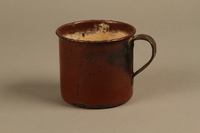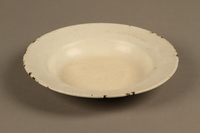Overview
- Description
- Contains photographs and an identification card illustrating the experiences of Malke and Shapsie and their son Moses, who were from Majdan, Poland and fled east into the Ural Mountains. Includes images from their time as displaced persons in Ulm, Germany, where their daughter Chana was born.
- Credit Line
- United States Holocaust Memorial Museum Collection, Gift of Anna Moscovitch
Physical Details
- Genre/Form
- Photographs. Identification card.
- Extent
-
1 folder
Rights & Restrictions
- Conditions on Access
- There are no known restrictions on access to this material.
- Conditions on Use
- Material(s) in this collection may be protected by copyright and/or related rights. You do not require further permission from the Museum to use this material. The user is solely responsible for making a determination as to if and how the material may be used.
Administrative Notes
- Holder of Originals
-
United States Holocaust Memorial Museum
- Legal Status
- Permanent Collection
- Provenance
- Donated to the United States Holocaust Memorial Museum in 2018 by Anna Moscovitch.
- Record last modified:
- 2024-03-08 07:34:57
- This page:
- https://collections.ushmm.org/search/catalog/irn624354
Download & Licensing
- In Copyright - Use Permitted
- Terms of Use
- This record is not digitized and cannot be downloaded online.
In-Person Research
- Request 7 Days in Advance of Visit
- Plan a Research Visit
-
Request in Shapell Center Reading Room
Bowie, MD
Contact Us
Also in Charles and Malka Bilfeld family Collection
The collection consists of prayer books, a cup, a bowl, an identification card, and photographs relating to the experiences of Szapse (Charles) and Malka Bilfeld and their son Mozes (Marvin) in Poland and the Soviet Union before and during the Holocaust, and in Germany, where their daughter Chana (Anna) was born, and the United States after the Holocaust.
Date: approximately 1921-approximately 1998

Enameled metal drinking cup used by a Jewish infant in a displaced persons camp
Object
Enameled mug used by Chana (Anna) Bilfeld, as an infant living in Displaced Persons (DP) camps near Ulm, Germany, with her family between 1948 and 1949. Chana was born in 1948, to Szapse and Malka Fuchs Bilfeld. Chana's parents, her brother Mozes, and her Bilfeld and Fuchs relatives were living in Maidan / Majdan Królewski (also known as Kolbuszowa), Poland, when German forces invaded on September 12, 1939. Majdan remained under German control when the Soviet Union annexed eastern Poland in mid-September. By the beginning of 1940, Jews in Majdan were only allowed to leave the village if they did so as part of a forced labor battalion. In July, Szapse, Malka, Mozes, Szapse’s brother, Yankel, and most of the Fuchs family fled east into Soviet-occupied Poland. They hid for more than a year, resting during the day, traveling at night, and stealing food as needed. In 1941, they found themselves in Kamionka Struminlova (now Kam'ianka-Buz’ka, Ukraine). Later, they continued traveling to the east, and spent time hiding in the mountainous areas near many towns in the Soviet Union. During 1942, the family was forced into slave labor camps in the region. After the war ended in May 1945, the Bilfeld and Fuchs families made their way to the American zone in Germany. Szapse learned that his parents and three other siblings had been killed, possibly in 1941. In Ulm, Malka’s family was reunited with Leiser. In November 1949, the Bilfeld family immigrated to the United States, and most of the Fuchs family immigrated to Israel.

Enameled metal soup plate used by a Jewish Polish man in a displaced persons camp
Object
Enameled bowl used by Szapse (Charles) Bilfeld while living in Displaced Persons (DP) camps near Ulm, Germany, with his family between 1946 and 1949. Szapse, his wife Malka, their son Mozes, and their Bilfeld and Fuchs relatives were living in Majdan / Majdan Królewski (also known as Kolbuszowa), Poland, when German forces invaded on September 12, 1939. Majdan remained under German control when the Soviet Union annexed eastern Poland in mid-September. By the beginning of 1940, Jews in Majdan were only allowed to leave the village if they did so as part of a forced labor battalion. In July, Szapse, Malka, Mozes, Szapse’s brother, Yankel, and most of the Fuchs family fled east into Soviet-occupied Poland. They hid for more than a year, resting during the day, traveling at night, and stealing food as needed. In 1941, they found themselves in Kamionka Struminlova (now Kam'ianka-Buz’ka, Ukraine). Later, they continued traveling to the east, and spent time hiding in the mountainous areas near many towns in the Soviet Union. During 1942, the family was forced into slave labor camps in the region. After the war ended in May 1945, the Bilfeld and Fuchs families made their way to the American zone in Germany. Szapse learned that his parents and three other siblings had been killed, possibly in 1941. In Ulm, Malka’s family was reunited with Leiser. In 1948, Malka gave birth to their daughter, Chana. In November 1949, the Bilfeld family immigrated to the United States, and most of the Fuchs family immigrated to Israel.
Inscribed Ashkenazic Siddur used by a Jewish Polish man in a displaced persons camp
Object
Hebrew prayer book used by Szapse (Charles) Bilfeld while living in Displaced Persons (DP) camps near Ulm, Germany, with his family between 1946 and 1949. Szapse, his wife Malka, their son Mozes, and their Bilfeld and Fuchs relatives were living in Majdan / Majdan Królewski (also known as Kolbuszowa), Poland, when German forces invaded on September 12, 1939. Majdan remained under German control when the Soviet Union annexed eastern Poland in mid-September. By the beginning of 1940, Jews in Majdan were only allowed to leave the village if they did so as part of a forced labor battalion. In July, Szapse, Malka, Mozes, Szapse’s brother, Yankel, and most of the Fuchs family fled east into Soviet-occupied Poland. They hid for more than a year, resting during the day, traveling at night, and stealing food as needed. In 1941, they found themselves in Kamionka Struminlova (now Kam'ianka-Buz’ka, Ukraine). Later, they continued traveling to the east, and spent time hiding in the mountainous areas near many towns in the Soviet Union. During 1942, the family was forced into slave labor camps in the region. After the war ended in May 1945, the Bilfeld and Fuchs families made their way to the American zone in Germany. Szapse learned that his parents and three other siblings had been killed, possibly in 1941. In Ulm, Malka’s family was reunited with Leiser. In 1948, Malka gave birth to their daughter, Chana. In November 1949, the Bilfeld family immigrated to the United States, and most of the Fuchs family immigrated to Israel.
Inscribed Siddur carried through hiding and slave labor by a Jewish Polish survivor
Object
Hebrew prayer book carried by Szapse (Charles) Bilfeld while living in hiding and then as a forced laborer in the Soviet Union, with his family from 1940 to 1945. Szapse, his wife Malka, their son Mozes, and their Bilfeld and Fuchs relatives were living in Majdan / Majdan Królewski (also known as Kolbuszowa), Poland, when German forces invaded on September 12, 1939. Majdan remained under German control when the Soviet Union annexed eastern Poland in mid-September. By the beginning of 1940, Jews in Majdan were only allowed to leave the village if they did so as part of a forced labor battalion. In July, Szapse, Malka, Mozes, Szapse’s brother, Yankel, and most of the Fuchs family fled east into Soviet-occupied Poland. They hid for more than a year, resting during the day, traveling at night, and stealing food as needed. In 1941, they found themselves in Kamionka Struminlova (now Kam'ianka-Buz’ka, Ukraine). Later, they continued traveling to the east, and spent time hiding in the mountainous areas near many towns in the Soviet Union. During 1942, the family was forced into slave labor camps in the region. After the war ended in May 1945, the Bilfeld and Fuchs families made their way to the American zone in Germany. Szapse learned that his parents and three other siblings had been killed, possibly in 1941. In Ulm, Malka’s family was reunited with Leiser. In 1948, Malka gave birth to their daughter, Chana. In November 1949, the Bilfeld family immigrated to the United States, and most of the Fuchs family immigrated to Israel.



